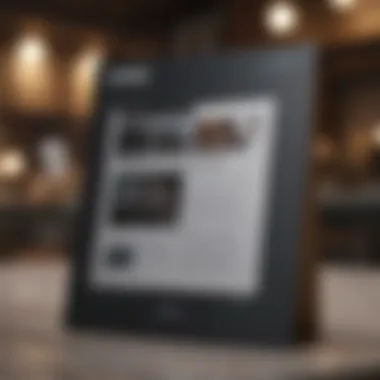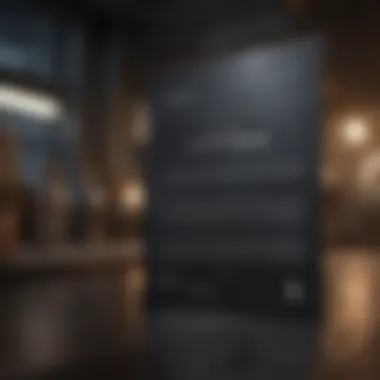Unveiling Inspiring Newsletter Layout Examples for Enhanced Communication Strategies


Entrepreneurial Insights
Among the pivotal aspects to consider in newsletter layout design are the visual hierarchy, content organization, and alignment of elements to facilitate a seamless reading experience. Entrepreneurs can learn from successful communication strategies that prioritize clarity and user-centric design to enhance brand messaging and audience connection.
Case Studies and Real-Life Examples
Real-world examples offer tangible evidence of how newsletter layout impacts communication effectiveness. By analyzing case studies of successful newsletter campaigns, entrepreneurs can glean valuable insights into design choices that prompted higher engagement rates and strengthened brand loyalty.
Exploring examples of newsletter layouts employed by industry leaders and innovative startups can inspire entrepreneurs to experiment with diverse formats and techniques. Understanding the rationale behind each design decision and its impact on audience perception empowers entrepreneurs to craft newsletters that resonate with their target demographics.
Introduction
In the realm of effective communication strategies, newsletter layout plays a pivotal role. It serves as the visual gateway through which information is disseminated to the audience, making it imperative to grasp its significance and nuances. A well-crafted newsletter layout can captivate readers, enhance engagement, and ultimately drive desired actions. This article delves deep into exploring various newsletter layout examples, dissecting their styles, structures, and functionalities to equip aspiring entrepreneurs, small business owners, sales professionals, and corporate executives with the knowledge and insights needed to craft compelling newsletters that resonate with their target audience.
Newsletter layout design is not merely about aesthetics. It intertwines art with functionality to create a seamless user experience. By harnessing the power of visual hierarchy, typography, color schemes, and whitespace, a newsletter layout can convey information effectively and entice readers to delve deeper. Understanding the intricate balance between visual appeal and readability is key to crafting newsletters that not only look visually appealing but also offer a smooth reading experience. Moreover, in today's fast-paced digital landscape, where attention spans are fleeting, a well-structured newsletter layout can mean the difference between capturing attention and losing it amidst the online noise.
The crux of newsletter layout design lies in its ability to strike a delicate balance between form and function. While visually engaging design elements can attract readers at first glance, it is the seamless integration of content within the layout that sustains their interest. An effective newsletter layout should seamlessly guide readers through the content, making information easily accessible and digestible. Moreover, with the rise of mobile consumption, responsiveness has become non-negotiable. Newsletters that adapt seamlessly to various screen sizes ensure a consistent user experience across devices, reinforcing brand credibility and accessibility.
In the ever-evolving landscape of digital marketing, newsletters remain a timeless tool for engaging audiences and fostering brand loyalty. Crafting a compelling newsletter layout requires a meticulous understanding of design principles, user behavior, and brand identity. By dissecting newsletter layout examples and unraveling their intricacies, this article aims to empower readers with the knowledge and inspiration needed to elevate their communication strategies through thoughtful and effective newsletter design.
Understanding Newsletter Layout Importance
A crucial element in enhancing communication strategies is the layout of newsletters. The way information is presented impacts engagement and readability. Effective newsletter layouts can capture attention, convey messages clearly, and compel action. Understanding Newsletter Layout Importance delves into the significance of design choices such as color schemes, images, fonts, and whitespace. By optimizing these aspects, businesses can cultivate a cohesive brand identity, improve user experience, and drive conversions.
Enhancing Visual Appeal
Utilizing Color Schemes
Color schemes play a pivotal role in evoking emotions, setting the tone, and establishing brand recognition. Choosing the right colors can convey professionalism, creativity, or trustworthiness. By strategically employing color palettes that align with the brand and target audience preferences, businesses can create a visually appealing and memorable newsletter that resonates with readers.
Incorporating Images and Graphics
Images and graphics enhance visual interest, break up text-heavy content, and provide context to information. Including relevant visuals can reinforce messaging, increase comprehension, and foster a connection with the audience. When used thoughtfully, images and graphics can strengthen the overall impact of the newsletter, driving engagement and retention.


Improving Readability
Font Selection and Size
The choice of font type and size directly influences how easily readers can consume the content. Selecting legible fonts and appropriate sizes is essential for readability across different devices. Fonts should align with brand guidelines, reflect the intended tone of the newsletter, and ensure accessibility for all recipients. Proper font selection enhances coherence and comprehension, making the newsletter more user-friendly.
Whitespace Management
Whitespace, or negative space, is instrumental in guiding readers' focus, organizing content, and preventing visual clutter. Adequate whitespace enhances readability by offering visual breathing room, improving content flow, and highlighting key information. Strategic whitespace management contributes to a balanced layout, reinforces hierarchy, and provides a pleasant reading experience for subscribers.
Types of Newsletter Layouts
In the realm of newsletter design, understanding the significance of different layout types is crucial for effective communication strategies. Whether opting for a single-column layout, a grid layout, or a masonry layout, each presents distinct benefits and considerations that cater to specific preferences and objectives. These layout styles serve as the backbone of how content is presented and consumed by the audience, impacting visual appeal, content organization, and overall engagement. By delving into the characteristics of each layout type, content creators can make informed decisions on the most suitable format for disseminating information to their subscribers.
Single Column Layout
Benefits and Drawbacks
The single-column layout, known for its simplicity and clean aesthetics, offers a streamlined approach to presenting content. Its uncluttered design encourages focused reading, allowing readers to navigate through information seamlessly. Despite its visual appeal, drawbacks may include limitations in accommodating diverse content types and potentially affecting the visual hierarchy within the newsletter. However, the prominence of this layout lies in its ability to emphasize one main story or message effectively, ideal for newsletters aiming for a minimalist and elegant presentation.
Suitable Content Types
Tailored for newsletters prioritizing narrative flow and storytelling, the single-column layout excels in showcasing compelling long-form content. Articles, case studies, and editorials find a perfect fit in this layout, enhancing readability and engagement. Such content types benefit from the uninterrupted flow of information, maximizing audience engagement and connection. However, for newsletters requiring diverse content formats like multiple features or varying media elements, the single-column layout may pose challenges in maintaining visual interest and complexity.
Grid Layout
Organizing Content Elements
The grid layout revolutionizes content structuring by offering a systematic arrangement of text, images, and other elements. By dividing the newsletter into a grid system, each section acquires a distinct placement, enabling content creators to categorize information effectively. This layout fosters a sense of order and balance, ensuring that different types of content receive equal visibility and emphasis. It provides a visually appealing structure that promotes easy navigation and content consumption for the readers, enhancing the overall user experience.
Enhancing Visual Hierarchy
Visual hierarchy plays a pivotal role in capturing readers' attention and guiding their focus within a newsletter. The grid layout excels in leveraging visual hierarchy techniques by strategically positioning key content elements for maximum impact. Through careful placement of headlines, images, and call-to-action buttons, content creators can create a hierarchy that prioritizes essential information and steers readers towards desired actions. This deliberate organization enhances content readability and engagement, compelling readers to interact with the newsletter effectively.


Masonry Layout
Dynamic Content Arrangement
The masonry layout stands out for its dynamic and flexible approach to content arrangement. Unlike rigid grid structures, masonry layouts boast varying column heights, displaying content in an artistic and visually captivating manner. This layout adapts seamlessly to different content dimensions, offering a unique and engaging browsing experience for recipients. With its fluid design, the masonry layout allows for creative content combinations, fostering curiosity and exploration among readers. The dynamic nature of this layout infuses newsletters with a modern and innovative aesthetic, setting them apart in a competitive digital landscape.
Engagement Opportunities
Emphasizing user interaction and engagement, the masonry layout presents abundant opportunities for captivating the audience's attention. By incorporating interactive elements, such as clickable tiles or animated transitions, content creators can enhance user experience and encourage active participation. The unconventional layout design stimulates curiosity and encourages readers to explore content further, increasing dwell time and fostering brand connection. Leveraging the masonry layout's engaging features, newsletters can create immersive experiences that resonate with subscribers, establishing a memorable and impactful communication channel.
Optimizing Newsletter Layout for Mobile Responsiveness
In the realm of effective communication strategies, optimizing newsletter layouts for mobile responsiveness plays a pivotal role in ensuring enhanced engagement and readability. With the growing dominance of mobile devices in digital consumption, adapting newsletters to different screen sizes becomes imperative. Responsive design principles are at the core of this optimization process, focusing on fluid layouts and flexible images that adjust seamlessly across various devices. These principles prioritize user experience by presenting content in a visually appealing and easily digestible format regardless of the screen dimensions. Through extensive testing and optimization, newsletter layouts can be fine-tuned to deliver a consistent and optimal viewing experience. By carefully considering clickable elements placement, users can navigate the content effortlessly, enhancing interaction and reducing user frustration. Implementing interactive features further enriches the mobile user experience, offering a dynamic and engaging platform for newsletter subscribers. Overall, by prioritizing mobile responsiveness in newsletter layout design, businesses can ensure that their content resonates effectively with audiences across different devices, maximizing reach and impact.
Best Practices in Newsletter Layout Design
In the realm of newsletter design, the aspect of best practices holds substantial significance. It serves as the cornerstone for creating compelling and effective newsletters that resonate with the audience in a meaningful way. By adhering to best practices in newsletter layout design, creators can ensure consistency, brand identity cohesiveness, and enhanced user experience. Through a meticulous approach to layout design, newsletters can effectively convey the intended message, establish a strong brand presence, and drive desired actions from the recipients. One of the pivotal elements within best practices is maintaining consistent branding elements throughout the newsletter. Whether it be through consistent logo placement or aligning the color palette, these practices contribute to a coherent and visually appealing design that reinforces brand recognition and recall among subscribers. By incorporating best practices in newsletter layout design, organizations can establish a strong foundation for effective communication and engagement with their target audience.
Consistent Branding Elements
Logo Placement
Logo placement plays a crucial role in the overall aesthetic and brand identity of a newsletter. Strategically positioning the logo within the layout reinforces brand recognition and fosters a sense of trust and familiarity among readers. The logo serves as a visual representation of the brand, making it a pivotal element in establishing brand identity within the newsletter design. Leveraging an appropriate size and placement for the logo ensures its prominence without overwhelming other content elements, striking a balance between visibility and cohesiveness. In the context of this article, focusing on logo placement as a key branding element can enhance brand recall and reinforce the brand's image effectively.
Color Palette Alignment
Color palette alignment is a fundamental aspect of maintaining brand consistency and visual harmony within newsletter layouts. By selecting and aligning colors that resonate with the brand identity, organizations can create a cohesive visual experience that reinforces brand recall and establishes a strong visual identity. Consistency in color usage across different elements of the newsletter enhances readability, facilitates brand recognition, and evokes desired emotional responses from the audience. However, meticulous attention is required to ensure that the color palette aligns with the brand's guidelines and conveys the intended brand image effectively. While color palette alignment contributes to visual aesthetics and brand recognition, it is essential to strike a balance between creativity and adherence to brand guidelines to maximize its impact within the newsletter design.
Call-to-Action Placement
Strategic Positioning
Strategic positioning of call-to-action elements is vital for driving desired outcomes and engagements within a newsletter. Placing calls-to-action at strategic junctures where they are prominently visible and easily accessible to readers can significantly increase click-through rates and conversions. A well-thought-out placement ensures that the call-to-action stands out within the layout, guiding readers towards the intended action seamlessly. Strategic positioning not only enhances the effectiveness of call-to-action elements but also optimizes the user journey within the newsletter, prompting desired responses from the audience. In the context of this article, emphasizing strategic positioning as a key aspect of call-to-action placement can boost engagement metrics and optimize the performance of newsletters.


Compelling Copywriting
Compelling copywriting serves as the backbone of persuasive communication within newsletters, guiding readers towards the desired actions and responses. Crafting compelling copy that resonates with the target audience, conveys the message effectively, and prompts specific actions can significantly impact the success of newsletter campaigns. From crafting enticing headlines to creating personalized content that appeals to the readers' interests, compelling copywriting plays a crucial role in capturing and retaining the audience's attention. By leveraging language that is engaging, clear, and action-oriented, organizations can create a sense of urgency and relevance within their newsletters, driving higher engagement and conversion rates. However, it is essential to maintain a balance between creativity and clarity in copywriting to ensure its effectiveness in eliciting responses from the audience effectively.
Interactive Elements in Newsletter Layouts
Interactive elements in newsletter layouts play a crucial role in enhancing user engagement and driving reader interaction. As modern audiences expect more dynamic and engaging content, incorporating interactive elements becomes essential for effective communication. By integrating features such as embedded videos and interactive infographics, newsletters can offer a more immersive and captivating experience to subscribers. These elements not only make the content visually appealing but also help in conveying information effectively.
Embedded Video Content
-#### Engagement Benefits
Embedded video content is a powerful tool for increasing user engagement within newsletters. The dynamic nature of videos can capture the audience's attention and deliver messages in a compelling manner. Through videos, businesses can showcase products, convey brand stories, or provide tutorial guides, leading to higher viewer retention and user interaction. This interactive approach not only improves the overall reading experience but also helps in conveying complex information more succinctly.
-#### Technical Considerations
Incorporating embedded video content requires careful consideration of technical aspects to ensure seamless integration and optimal performance. Factors such as video format compatibility, file size optimization, and loading speed are crucial for a smooth user experience. Balancing high-quality visuals with loading efficiency is key to preventing user frustration and maintaining engagement levels. Additionally, optimizing video content for different devices and internet connections enhances accessibility and ensures a consistent viewing experience for all subscribers.
Interactive Infographics
Interactive infographics offer a fresh way to present data and information, providing a visually compelling storytelling medium within newsletters. By combining interactive features with informative graphics, businesses can effectively engage readers and simplify complex concepts. This approach not only enhances content comprehension but also adds an element of interactivity that encourages exploration and active reader participation.
-#### Storytelling Potential
The storytelling potential of interactive infographics allows businesses to craft narratives and convey information in a highly engaging manner. By incorporating elements such as animated charts, interactive maps, and clickable data points, brands can create immersive storytelling experiences that captivate audiences. This storytelling approach not only educates readers but also fosters emotional connections and encourages deeper exploration of the content.
-#### Data Visualization
Data visualization in interactive infographics offers a dynamic way to represent complex information and statistical data. Through interactive charts, graphs, and data-driven animations, businesses can make data more accessible and understandable to readers. This visual representation not only enhances content clarity but also facilitates better decision-making by presenting insights in a visually appealing and interactive format.
Conclusion
In the realm of newsletter layout design, the conclusion serves as the pinnacle of the communication process. It encapsulates the essence of the content presented, offering a sense of closure and direction for the reader. The importance of the conclusion lies in its ability to leave a lasting impression on the audience, summarizing key takeaways and reinforcing the main message of the newsletter.
A well-crafted conclusion not only reiterates the primary purpose of the communication but also provides a call to action, encouraging readers to engage further with the content. By emphasizing the significance of the information shared and its implications, the conclusion acts as a catalyst for driving desired outcomes, whether it be increased readership, brand awareness, or conversions.
When crafting the conclusion for a newsletter layout, it is imperative to consider the specific elements that need to be highlighted. These may include key insights discussed in the content, actionable steps for the audience, or a compelling statement that resonates with the readers. By focusing on concise yet impactful messaging, the conclusion can leave a lasting impression and prompt the desired response from the recipients.
Moreover, the benefits of a well-executed conclusion extend beyond the immediate impact on readers. It contributes to building brand credibility, establishing a sense of trust and authority within the target audience. Additionally, a thoughtful conclusion reflects the commitment of the sender towards providing value and meaningful interactions, fostering long-term relationships with the subscribers.







